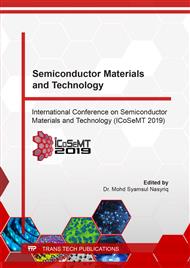[1]
M. Annadhasan, J. Kasthuri, and N. Rajendiran, Green synthesis of gold nanoparticles under sunlight irradiation and their colorimetric detection of Ni 2+ and Co 2+ ions,, RSC Adv., vol. 5, no. 15, p.11458–11468, Jan. (2015).
DOI: 10.1039/c4ra14034f
Google Scholar
[2]
Y. Zhang, H. Peng, W. Huang, Y. Zhou, and D. Yan, Facile preparation and characterization of highly antimicrobial colloid Ag or Au nanoparticles,, J. Colloid Interface Sci., vol. 325, no. 2, p.371–376, Sep. (2008).
DOI: 10.1016/j.jcis.2008.05.063
Google Scholar
[3]
C.-L. Liu et al., Insulin-Directed Synthesis of Fluorescent Gold Nanoclusters: Preservation of Insulin Bioactivity and Versatility in Cell Imaging,, Angew. Chemie Int. Ed., vol. 50, no. 31, p.7056–7060, Jul. (2011).
DOI: 10.1002/anie.201100299
Google Scholar
[4]
J. Yin et al., SERS-Active Nanoparticles for Sensitive and Selective Detection of Cadmium Ion (Cd 2+ ),, Chem. Mater., vol. 23, no. 21, p.4756–4764, Nov. (2011).
DOI: 10.1021/cm201791r
Google Scholar
[5]
A. Corma and H. Garcia, Supported gold nanoparticles as catalysts for organic reactions,, Chem. Soc. Rev., vol. 37, no. 9, p.2096, Aug. (2008).
DOI: 10.1039/b707314n
Google Scholar
[6]
C. Noguez and I. L. Garzón, Optically active metal nanoparticles,, Chem. Soc. Rev., vol. 38, no. 3, p.757, Feb. (2009).
DOI: 10.1039/b800404h
Google Scholar
[7]
A. I. Usman, A. Abdul Aziz, and O. Abu Noqta, APPLICATION OF GREEN SYNTHESIS OF GOLD NANOPARTICLES: A REVIEW,, J. Teknol., vol. 81, no. 1, Dec. (2018).
DOI: 10.11113/jt.v81.11409
Google Scholar
[8]
and G. K. W. Norsyuhada W. Shukri, Noriah Bidin*, Shumaila Islam, Synthesis of Au–Ag Alloy Nanoparticles in Deionized Water by Pulsed Laser Ablation Technique,, J. Nanosci. Nanotechnol, vol. 11, no. 7, p.4841–4851, (2018).
DOI: 10.1166/jnn.2018.15358
Google Scholar
[9]
B. K. Sodipo, A. Abdul, A. Letter, E. : Bashiru, and K. Sodipo, A sonochemical approach to the direct surface functionalization of superparamagnetic iron oxide nanoparticles with (3-aminopropyl)triethoxysilane,, Malaysia Beilstein J. Nanotechnol, vol. 11800, p.1472–1476, (2014).
DOI: 10.3762/bjnano.5.160
Google Scholar
[10]
N. A. Hammed, A. A. Aziz, A. I. Usman, and M. A. Qaeed, The sonochemical synthesis of vertically aligned ZnO nanorods and their UV photodetection properties: Effect of ZnO buffer layer,, Ultrason. Sonochem., Sep. (2018).
DOI: 10.1016/j.ultsonch.2018.09.020
Google Scholar
[11]
A. I. Usman and A. Abdul Aziz, Optimization of biosynthesis gold nanoparticles via central composite design toward monodisperse,, Mater. Res. Express, vol. 6, no. 1, p.015051, Oct. (2018).
DOI: 10.1088/2053-1591/aae954
Google Scholar
[12]
A. I. Usman, A. A. Aziz, and O. A. Noqta, Green sonochemical synthesis of gold nanoparticles using palm oil leaves extracts,, Mater. Today Proc., vol. 7, p.803–807, Jan. (2019).
DOI: 10.1016/j.matpr.2018.12.078
Google Scholar
[13]
A. Sugunan, C. Thanachayanont, J. Dutta, and J. G. Hilborn, Heavy-metal ion sensors using chitosan-capped gold nanoparticles,, Sci. Technol. Adv. Mater., vol. 6, no. 3–4, p.335–340, Jan. (2005).
DOI: 10.1016/j.stam.2005.03.007
Google Scholar
[14]
M. Annadhasan, T. Muthukumarasamyvel, V. R. Sankar Babu, and N. Rajendiran, Green Synthesized Silver and Gold Nanoparticles for Colorimetric Detection of Hg 2+ , Pb 2+ , and Mn 2+ in Aqueous Medium,, (2014).
DOI: 10.1021/sc400500z
Google Scholar
[15]
M. Annadhasan, Highly selective and sensitive colorimetric detection of Hg (II) ions using green synthesized silver nanoparticles Metal nanoparticles based sensor View project Metal nanoparticles based devices View project,, (2015).
DOI: 10.1039/c5ra18106b
Google Scholar
[16]
L. M. Liz-Marzán, Nanometals: formation and color, Mater.,, Mater. today, vol. 7, p.26–31, (2004).
Google Scholar
[17]
P. Bollella et al., Green Synthesis and Characterization of Gold and Silver Nanoparticles and their Application for Development of a Third Generation Lactose Biosensor,, Electroanalysis, vol. 29, no. 1, p.77–86, (2017).
DOI: 10.1002/elan.201600476
Google Scholar
[18]
E. B. El, E. B. El Domany, T. M. Essam, A. E. Ahmed, and A. A. Farghali, Biosynthesis Physico-Chemical Optimization of Gold Nanoparticles as Anti-Cancer and Synergetic Antimicrobial Activity Using Pleurotus ostreatus Fungus ARTICLE INFO ABSTRACT,, J. Appl. Pharm. Sci., vol. 8, no. 05, p.119–128, (2018).
DOI: 10.7324/japs.2018.8516
Google Scholar
[19]
S. Ahmed, Annu, S. Ikram, and S. Yudha S., Biosynthesis of gold nanoparticles: A green approach,, J. Photochem. Photobiol. B Biol., vol. 161, p.141–153, Aug. (2016).
DOI: 10.1016/j.jphotobiol.2016.04.034
Google Scholar
[20]
T. Ahmad, I. A. Wani, N. Manzoor, J. Ahmed, A. Kalam, and A. S. Al-Shihri, Structural Characterization, Antifungal Activity and Optical Properties of Gold Nanoparticles Prepared by Reverse Micelles,, Adv. Sci. Lett., vol. 20, no. 7, p.1631–1636, Jul. (2014).
DOI: 10.1166/asl.2014.5589
Google Scholar
[21]
R. Majumdar, B. G. Bag, and P. Ghosh, Mimusops elengi bark extract mediated green synthesis of gold nanoparticles and study of its catalytic activity,, Appl. Nanosci., vol. 6, no. 4, p.521–528, (2016).
DOI: 10.1007/s13204-015-0454-2
Google Scholar
[22]
K. B. Narayanan and N. Sakthivel, Coriander leaf mediated biosynthesis of gold nanoparticles,, Mater. Lett., vol. 62, no. 30, p.4588–4590, Dec. (2008).
DOI: 10.1016/j.matlet.2008.08.044
Google Scholar


